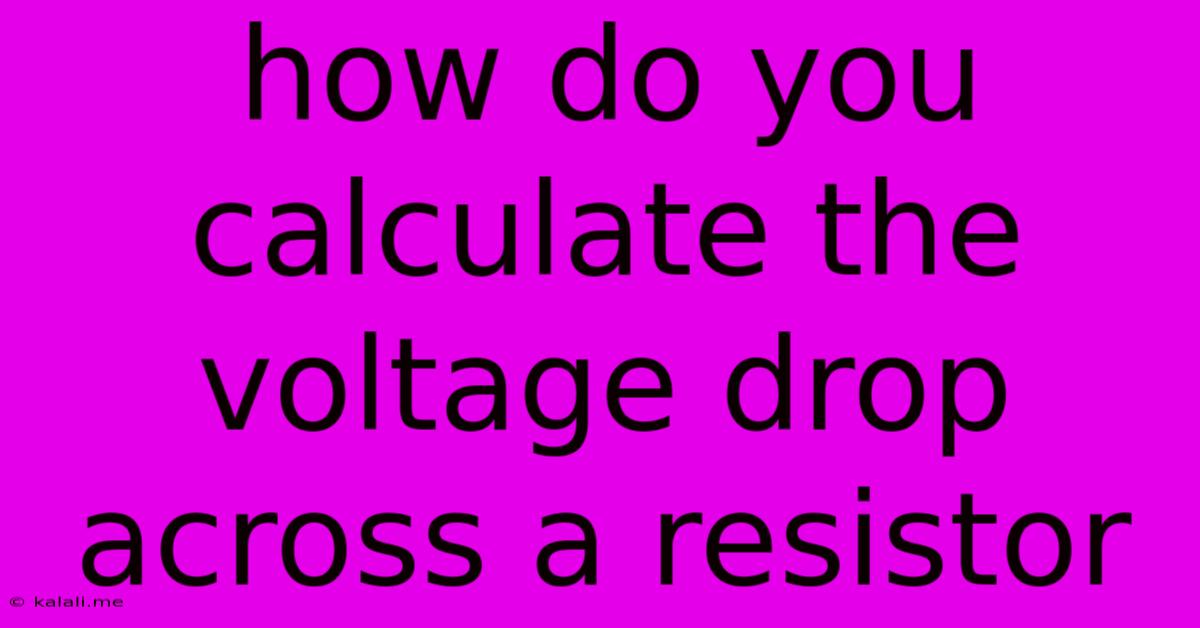How Do You Calculate The Voltage Drop Across A Resistor
Kalali
Jun 11, 2025 · 3 min read

Table of Contents
How to Calculate Voltage Drop Across a Resistor: A Comprehensive Guide
Calculating the voltage drop across a resistor is a fundamental concept in electrical engineering and circuit analysis. Understanding this calculation is crucial for designing and troubleshooting various electronic circuits. This guide will walk you through the process, explaining the underlying principles and providing practical examples. We'll cover Ohm's Law, series and parallel circuits, and how to apply these concepts to real-world scenarios.
Understanding Ohm's Law: The Foundation of Voltage Drop Calculation
Ohm's Law is the cornerstone of electrical circuit analysis. It establishes the relationship between voltage (V), current (I), and resistance (R) in a circuit. The formula is:
V = I * R
Where:
- V represents the voltage measured in volts (V).
- I represents the current measured in amperes (A).
- R represents the resistance measured in ohms (Ω).
This simple equation allows us to calculate any of these three variables if we know the other two. For calculating voltage drop across a resistor, we'll use this formula directly. The voltage drop is simply the voltage difference across the resistor.
Calculating Voltage Drop in a Simple Circuit
Let's consider a simple circuit with a single resistor connected to a voltage source. If we know the current flowing through the resistor and its resistance, we can directly apply Ohm's Law to find the voltage drop:
Example:
A 10Ω resistor is connected to a 12V battery. The current flowing through the resistor is measured as 1.2A. What is the voltage drop across the resistor?
Using Ohm's Law:
V = I * R = 1.2A * 10Ω = 12V
In this case, the voltage drop across the resistor is equal to the voltage of the source because there are no other components in the circuit.
Calculating Voltage Drop in Series Circuits
In a series circuit, components are connected end-to-end, forming a single path for current flow. The current remains constant throughout the entire circuit. To calculate the voltage drop across individual resistors in a series circuit, we apply Ohm's Law to each resistor individually. The sum of individual voltage drops across each resistor will equal the total voltage of the source.
Example:
Two resistors, R1 (5Ω) and R2 (15Ω), are connected in series to a 20V battery. What is the voltage drop across each resistor?
- Calculate the total resistance: Rtotal = R1 + R2 = 5Ω + 15Ω = 20Ω
- Calculate the current: I = V / Rtotal = 20V / 20Ω = 1A
- Calculate the voltage drop across R1: V1 = I * R1 = 1A * 5Ω = 5V
- Calculate the voltage drop across R2: V2 = I * R2 = 1A * 15Ω = 15V
Calculating Voltage Drop in Parallel Circuits
In a parallel circuit, components are connected across each other, providing multiple paths for current flow. The voltage across each component in a parallel circuit is the same, equal to the source voltage. The current, however, is divided among the branches. To calculate the voltage drop across each resistor in a parallel circuit, it's simply the source voltage.
Example:
Two resistors, R1 (5Ω) and R2 (10Ω), are connected in parallel to a 10V battery. What is the voltage drop across each resistor?
The voltage drop across both R1 and R2 is 10V. This is because the voltage is the same across all components connected in parallel.
Advanced Considerations and Troubleshooting
While Ohm's Law provides a foundation, real-world circuits often involve more complex scenarios. Factors such as internal resistance of voltage sources, tolerances of resistors, and non-linear components can affect voltage drop calculations. Advanced techniques, such as Kirchhoff's Laws, are needed to analyze more intricate circuits.
Understanding how to calculate voltage drop across a resistor is a crucial skill for anyone working with electrical circuits. By mastering Ohm's Law and understanding series and parallel circuit behavior, you can effectively analyze and design a wide range of electronic systems. Remember to always prioritize safety when working with electrical circuits.
Latest Posts
Latest Posts
-
What Is The Square Root Of 676
Jun 12, 2025
-
Which Of The Following Is Not An Operating System
Jun 12, 2025
-
What Hemisphere Is India Located In
Jun 12, 2025
-
Logical Reasoning Test And Answers Pdf
Jun 12, 2025
-
Tsunamis Are The Result Of
Jun 12, 2025
Related Post
Thank you for visiting our website which covers about How Do You Calculate The Voltage Drop Across A Resistor . We hope the information provided has been useful to you. Feel free to contact us if you have any questions or need further assistance. See you next time and don't miss to bookmark.